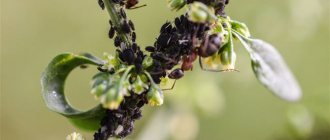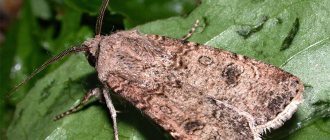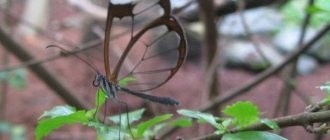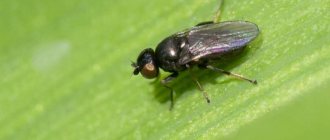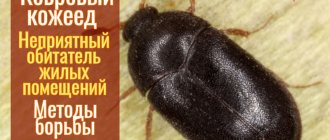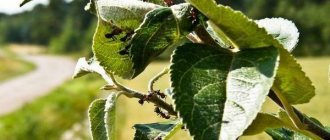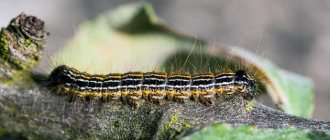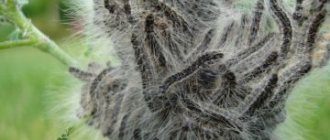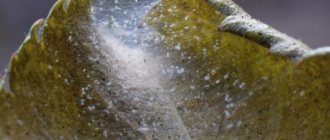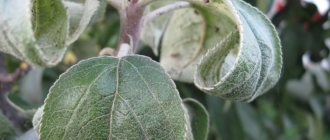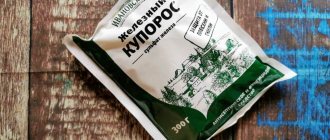Leaf roller is a dangerous pest that damages buds, leaves and fruits. In case of a massive invasion, they can destroy most of the crop. It is easy to distinguish from other pests - the larvae roll apple tree leaves into tubes or bundles .
The sooner the fight against leaf rollers on apple trees begins, the more effective it will be. This is especially important for young apple trees, in which the loss of a large number of leaves will disrupt the process of photosynthesis and can be disastrous.
From our article you can learn how to get rid of leaf rollers on an apple tree .
Appearance of the pest
The leaf roller is a small butterfly with a plump, hairy body and small wingspan, no more than 2.5 cm .
The color of the wings varies from gray to various shades of brown, often with a distinct pattern of darker colors in the form of stripes or ornaments.
She folds her wings not vertically, like most butterflies, but horizontally, completely covering her body with them. Butterflies fly out late in the evening and at night , and during the day they hide in shelters.
The greatest damage to apple trees is caused by caterpillar larvae. Caterpillars have a smooth body, the color can be yellowish, brown, greenish or brown. The head is brown or black. They feed on buds, young leaves, and some varieties even reach fruits.
The life cycle depends on the type of leafroller; it differs in the timing of the appearance of caterpillars, the wintering place, and the time of departure of butterflies.
Leaf rollers are dangerous for apple trees:
- Rosanna;
- Currant;
- Omnivore;
- Fruit;
- Kidney spinner.
Egg clutches overwinter on branches, caterpillars - in a dense cocoon in cracks in the trunk, on shoots near the buds, in dried curled leaves. The emergence of the caterpillars coincides with the swelling of the buds or the beginning of flowering.
In June, they pupate in folded leaves for 10–14 days, after which butterflies fly out and make several clutches of eggs over the course of a month. The eggs develop for about two weeks, after which new caterpillars appear, which roll up the leaves with the help of a web, gnaw them, and sometimes even get to the fruits.
This is what a leaf roller looks like on an apple tree - photo of butterflies:
Rose leaf roller.
Currant leaf roller.
The leaf roller is omnivorous.
Fruit leaf roller.
Bud roller.
Reasons for appearance
The leaf roller appears on the apple tree and multiplies quickly if the garden is not well maintained. Weak, diseased trees are the first to be affected.
When nothing threatens or interferes with the existence of pests, they fill all suitable places. In addition to apple trees, cherries, pears, lindens and rowan trees are also at risk. If they grow nearby, leaf rollers are likely to choose this particular area.
Inaction and lack of control will lead to the spread of the pest throughout the entire area. Other plants may become infected.
Why is it dangerous?
Leafworm caterpillars harm apple trees throughout the growing season.
The first caterpillars damage flower buds , which reduces the formation of fruit ovaries. After flowering, they move to the tops of young shoots, eat and curl the apical leaves , which leads to growth retardation.
This is especially dangerous for young apple trees in which the crown is forming. In the second half of summer, the caterpillars move on to the fruits , eating holes in them.
During mass reproduction, leaf rollers move to other fruit trees and shrubs in the garden.
Leaf roller on an apple tree: how to fight?
Advice! Chemical treatment is carried out if, upon inspection of a tree, more than 5 caterpillars are found on one branch.
For protection, it is necessary to spray not only the apple tree, but also other trees and shrubs growing nearby.
Leaf roller butterflies migrate and invade nearby areas.
How to treat an apple tree against leaf roller? To combat lepidoptera, which includes leafrollers, the following are effective:
- "Avant" - affects caterpillars at any stage of their development; treatment can be carried out on egg layings. Apply no more than 2 times per season, the interval between treatments is 14 days. Resistant to rain;
- “Decis-profi” - the advantage of the drug is the speed of action and the absence of phytotoxicity;
- "Inta-Vir" - affects caterpillars, repels butterflies. One tree will require 5 liters of solution, treatment is carried out 25 days before harvest. Not used as prophylaxis;
- "Calypso" - protection for up to 30 days, low toxicity for beneficial insects, no addiction of pests to this drug has been observed;
- "Kinmiks" - the speed of action on pests is about 1 hour, it remains on the surface of the leaves for a long time.
When choosing what to spray an apple tree against leaf roller, you should take into account the growing season, the degree of pest damage to the garden, weather conditions and air temperature.
Watch the video for tips on how to combat leaf rollers:
What drugs to use
Insecticidal agents for chemical control are divided into two groups:
- contact – destroy the pest when it comes into contact with it;
- systemic - destroy the pest through the treated plant.
Contact preparations are low-toxic and therefore have low effectiveness. Systemic ones are more toxic, therefore more effective. The choice of drug is influenced by:
- weather;
- degree of damage;
- vegetation stage.
For prevention and with a small number of pests, gardeners use broad-spectrum insecticides:
- "Alatar"
- "Karbofos"
- "Atom",
- "Ditox."
*Chemicals are used only before and after flowering, also after harvesting.
During fruit formation, they are treated with biologically active drugs:
- "Dendrobazzelin";
- "Fitoverm";
- "Lepidocide."
In case of a massive pest invasion, trees are sprayed with stronger agents:
- synthetic pyrethroids: “Ivanhoe”, Fatrin”, “Fastak”, “Accord”;
- pesticides: “Inta-Vir”, “Avant”, “Dimilin”, “Kinmiks”.
*These products are highly toxic and therefore dangerous to humans. The use is justified if other methods are ineffective.
Processing times
In the spring, even before the buds open, you should inspect the apple trees . If egg clutches are found near the buds and on the shoots, the treatment should be carried out when the flower buds begin to turn pink .
If white cocoons are found in cracks in the bark, it means that caterpillar larvae will emerge from them. Treatment against them is carried out in the green cone phase.
The green cone is the phase of bud opening: they have swollen, burst and released the tips of the leaves. This period is very short-lived, it is important not to miss it.
If you manage to carry out processing at this time, the first generation caterpillars will be destroyed. This will allow the apple tree to fully bloom and form ovaries.
Since leafrollers migrate, they can fly from other places. In the future, you should monitor the appearance of butterflies or the first caterpillars by regularly inspecting the trees. The following treatment should be carried out when pests are first detected.
IMPORTANT! Treatment cannot be carried out during flowering, because all recommended insecticides are dangerous for bees.
When using medications, you should act according to the instructions and take into account the air temperature. If the treatment is carried out at a higher, or vice versa, low temperature, the product will not work.
Methods of controlling bark beetles without the use of pesticides
The fight against bark beetle can be carried out not only with the use of chemicals. There are other simple methods that are safe for humans and the environment.
Traps and repellers
The use of antipheromone repellers, which are tablets impregnated with special substances, is quite effective. These products are hung 7-10 days before the mass flight; the unpleasant odor emanating from them will help drive away pests from the garden. Repellers do not pose any harm to humans and the environment.
The use of pheromone traps is recommended in gardens with an area of at least 5 hectares, otherwise serious harm can be caused to the trees.
Injection of the barrel
Once the bark beetle has penetrated the wood tissue, spraying and traps lose their effectiveness. In this case, pest control is carried out by introducing special preparations into the flight openings of insects. The procedure requires the presence of a medical syringe and an insecticide, which can be Confidor Maxi, Calypso or Tanrek. After the event is completed, the holes are covered with garden varnish.
To destroy bark beetles on valuable varieties of fruit trees, it is best to use a professional intra-trunk injection.
Boosting immunity
Since the bark beetle prefers to settle on depleted and weakened garden crops, one of the methods of combating it is to increase immunity. To do this you need to follow several rules:
- prevent injury to trees;
- carry out competent processing of fresh cuts and sections using garden varnish;
- fertilize regularly;
- provide abundant watering on hot days;
- promptly get rid of weeds growing near apple trees;
- periodically cultivate the soil in tree trunk circles.
Folk remedies
As an additional measure to combat the pest, self-prepared formulations are used; such a solution allows you to achieve the desired result in a shorter time. The following are considered the most popular:
- Carbolic acid (400 g) combined with soap (400 g) and water (5 l). The resulting composition is further diluted with water in a ratio of 1:4 and used to spray the garden before the flowering period begins and immediately after its completion.
- Oil paint – the affected areas are generously coated with this material. Whitewashing works well as an alternative.
The establishment of a bark beetle in an orchard can lead not only to crop loss, but also to the death of trees. To prevent this, it is necessary to begin treatment immediately after detection.
Previous Pests How to get rid of ants on an apple tree: the best methods of control Next Pests How to protect an apple tree from rodents for the winter: the best ways to cover the trunk and branches
Other methods and measures
If the apple tree is only slightly , then the curled leaves should be torn off . They are collected carefully, because the caterpillars, despite their apparent slowness, can quickly slip out of the leaf.
The leaves must be burned. If you simply throw them out of the area or into a compost heap, the larva will go through the entire development cycle in a folded leaf, and then return to the apple tree in the form of a butterfly.
To combat leaf rollers, birds should be attracted to the garden. You can hang feeders on apple trees and sprinkle some unroasted seeds into them. You shouldn’t pour in a lot of food, because the birds will be full and won’t look for caterpillars and butterflies.
are hung at a height of 1.5 meters . To do this, cut off the neck of a plastic bottle and attach it to the barrel.
kvass, compote, beer, and sweet tea are poured as bait They hang it in the evening and remove it or close it in the morning to prevent beneficial insects from getting inside.
During the day, butterflies hide on the trunk of an apple tree or on branches under the leaves. Due to their color, they are almost invisible on the bark, but upon careful examination they can be detected. They should be collected and destroyed.
You can hang hunting belts made of burlap or thick paper , and apply garden glue to them. You will need to hang several belts on one tree. The belt is hung in the spring and removed in the fall after the leaves have fallen.
In winter, tits are assistants in pest control . They are attracted to pieces of unsalted lard. Tits are able to peck most of the caterpillars from cracks in the bark.
Methods of combating ermine (bird cherry) moths
The ermine moth causes damage to trees in the larval stage. By eating leaves on trees, it weakens the immunity of fruit crops, reducing productivity and increasing susceptibility to various diseases and other pests.
There are several methods to combat the pest and its caterpillars.
- Mechanical. Every day in the spring it is necessary to inspect the trees and identify spider web nests. Affected branches should be plucked or cut down and then burned. This method is suitable for small numbers of pests.
- Biological. Using special pheromone traps for males. This helps reduce the moth population, since without males the females will not be able to reproduce. Biological products can also work - Lepidocide, Bitoxibacillin, designed to combat leaf-eating pests.
- Chemical. When the caterpillars become more and more numerous, only strong insecticides will help to cope with them. Treatment should begin as soon as the first signs of pests are visible.
It is better to start protective measures in the fall, without escalating the situation to a serious situation. To do this, when preparing trees for winter, they remove old fallen leaves and burn them. The soil around the trees is loosened. You can pour a concentrated 7% urea solution (700 g of urea per 10 liters of water). This way you kill the fungal infection and get rid of pests that overwinter in fallen leaves.
In adult apple trees, the old bark is peeled off; other types of pests can overwinter in it, and then the trunk is whitewashed with whitewash or paint.
Folk remedies
IMPORTANT! Folk remedies only help if the pest infestation is small.
Treatment with a decoction of wormwood, potato tops or tomato leaves repels
butterflies . To prepare the decoction:
- Fill the bucket 1/3 with chopped herbs, add water and boil for half an hour;
- Let it brew for 3-4 hours;
- Strain;
- Dilute with water to a volume of 10 liters;
- Add half a glass of thick liquid soap;
- Spray with this solution.
Treatment is carried out in the morning or evening, when there is no wind and rain is not expected.
against caterpillars . For this:
- 500 grams of tobacco dust is poured into a bucket of boiling water;
- Leave for 2-3 days;
- Strain;
- Add water twice the original volume after straining;
- For stickiness, pour in a little liquid soap.
The solution is not stored; processing is carried out immediately after preparation.
Preventative treatment
In order to minimize damage to apple trees , it is necessary to monitor garden hygiene:
- All fallen leaves and fruits must be collected in a timely manner, dry and diseased branches must be cut out, the soil must be loosened and weeds must be removed;
- The crown of the apple tree should not be thickened. A thinned crown is not only important for apple tree fruiting, but also for the prevention of diseases and pests;
- In the autumn, after the leaves have fallen, the trunks must be cleaned with a stiff brush from flaking pieces of bark, and all egg masses, moss and lichens must be cleaned off;
- In the fall, the trunks are treated with a thick solution of lime or special garden paint.
Cleaning the trunk of an apple tree with a brush.
Prevention measures
To prevent plants in the garden from becoming victims of the leaf roller, proper agricultural technology and regular preventive measures are very important. The following actions will help maintain the health and strong immunity of fruit trees and berry bushes:
- timely watering, weeding, pruning and fertilizing of plants;
- regular loosening of the soil around the tree trunk;
- daily cleaning of fallen leaves and fruits;
- annual cleaning and whitewashing of the bark on the trunk and skeletal branches;
- preventive treatment with copper sulfate or Bordeaux mixture.
Useful tips
When inspecting the garden, first of all you should pay attention to young shoots and leaves at the tops of branches .
Fresh greens are the most delicious morsel for caterpillars. Any curled leaf must be torn off and destroyed.
Insecticides should not be used during flowering and 25 days before harvest. All of the above products belong to class 3 toxicity for humans and remain in the fruit for a long time.
In warm and humid weather, control over apple trees needs to be strengthened. At this time, the caterpillars become very voracious, and the butterflies become active.
Symptoms of the lesion
It is very easy to detect damage on branches, shoots, fruits and leaves. Signs of damage depend on the season of the year:
- in early spring - a thin cobweb appears;
- in mid-spring - eaten shoots, buds, flowers, cobwebs;
- at the end of spring - curled leaves;
- at the beginning of summer - cocoons appear;
- in mid-summer - thick cobwebs and increased activity of butterflies;
- at the end of summer - green shoots with dark spots;
- in autumn - a large number of twisted leaves, fruits in a web.
